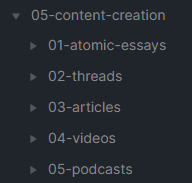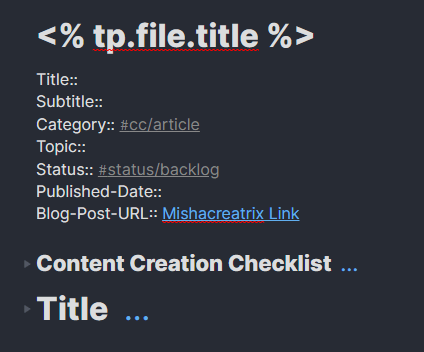There are lots of ways to create and distribute content online these days.
There are so many social media and content platforms I've lost count. While this is a huge plus for online creators like me, it can also be challenging to know where to start. This is why learning where to focus your efforts to have the most impact is so important.
You can try to be everywhere sure, but without a proper system or guiding star, you'll burn out pretty quickly.
This is why I spent the last few weeks brainstorming my "Content Creation Conveyor Belt". I wanted to make sure I was focusing my content creation efforts in the right places online without sinking too much time into it each week. The saying work smarter, not harder comes to mind here.
This article is a walkthrough of my content creation process, how I repurpose my content, and the tools I use to make it happen.
How It Works - An Overview
Let's start with a bird's eye view of the whole system. Here's a mind map I created to summarize everything:
As you can see, the system starts with the smallest unit of content, the idea, then works its way up to a larger, more fleshed-out idea.
Each stage of the system requires repurposing, adding, and removing content to make it suitable for the platform it will live on.
It's important to say here that not every idea will work well on every platform. I've had some ideas that made great tweets and great articles but aren't suited for threads. I've also had ideas that immediately turned into articles (like this one) without testing them out as essays or threads. Keep this in mind if you are looking to try this out for yourself.
The way I think about this is twofold: which format I feel would have the most impact and how fleshed out I think the idea is.
Take the idea for this article as an example (how I create and repurpose content). I feel pretty strongly that it would be more helpful as an article than a super concise essay or thread. I also know a lot about this topic so it's something I can almost write stream of consciously without thinking about and refining the idea.
This part of the system is definitely a personal preference but it's how I operate right now.
I should also note here this idea isn't mine, I took great inspiration from Ev Chapman's article: The Bottom’s Up Approach To Writing That 99% Guarantees A Successful Article. I highly recommend you read this article to get a sense of how this approach works. If you're a content creator and don't know who Ev Chapman is, fix that now!
Tweet
Initial ideas start life as Tweets.
If you think about it a Tweet is the best way to test an idea. It costs nothing, is very low effort, and can the results can be amazing.
I've often heard it said that a Tweet is like a lottery ticket.
Not sure where this idea originally came from but Alex Llull captures it really well in this Tweet:
https://twitter.com/AlexLlullTW/status/1468259087045562368
To manage the ideas for my Tweets, I use inboxes like Todoist, and a notebook to capture them as they come to me during the day.
I manage my Tweets in a Notion Dashboard I call the Tweet HUD. It allows me to refine the Tweet and repurpose it in different ways.
The best Tweets each week are repurposed to my Instagram using Poet.so. I use Poet.so to turn the Tweet into an image then manually post it on Instagram when I think of it. I'm not very regular about this process but it has been a proven way to increase my Instagram audience without much extra effort.
Essay/Thread
I use Twitter's Analytics to see my top-performing Tweets from the last week or so.
These best Tweets are perfect candidates to become atomic essays or threads. Sometimes I'll create both, sometimes I'll pick one, it depends on the idea and how well I think it would work.
Atomic essays are published on my website and on Typeshare.
Threads of course get published on Twitter. I use Zlappo to schedule my tweets and threads.
I manage writing my atomic essays and threads in Obsidian. I have dedicated folders for each type of content under a primary Content Creation folder.
Article
Essays or threads that did well are repurposed and expanded into longer-form articles.
Not all articles work like this though. This article for example I'm writing from scratch. I did share the mind map on Twitter but never turned the idea into a thread or an atomic essay.
I write my articles in Typora and manage them in Obsidian in an Articles folder.
Articles are published to my website and then cross-posted to Medium, Dev.to, and Hashnode. I also include a link to the article on my Changelog site.
Video
Now we come to the part of the process I don't actually follow yet. Currently, I don't have any video presence online but it's something I'm working on this year.
Here's how I plan to repurpose my content for video:
Articles will be turned into videos for YouTube. I'll either record myself speaking the article or talk to the camera off the cuff or with a rough outline.
These longer YouTube videos will be cut down into short snippets for Instagram, Twitter, and potentially TikTok.
Ship 30 for 30 does this to great effect:
https://twitter.com/ship30for30/status/1507800204493344771
Of course I'm sure this process will evolve as I start figuring everything out but for now this is the rough idea.
Podcast
Again, as with video, this isn't something I do yet but am hoping to get started with this year.
For the videos I created above, I can pull the audio out and create a podcast version of the content. Lots of popular podcasts + YouTube channels already do this so I'm not reinventing the wheel.
I plan to use Anchor to upload the podcasts as this service distributes content across all major podcasting services.
I could also pull out particular audio snippets and repurpose those on Twitter + Instagram.
Design Details is a super podcast that does this:
https://twitter.com/designdetailsfm/status/1506719010833924098
My Obsidian Setup For Content Creation
Little side tangent here but I'm sure there are lots of you wondering how this is all managed in Obsidian. Honestly, I could write a whole article about how I use Obsidian for content creation but for the purposes of this article, I'll keep it brief.
I have a Content Creation directory which is subdivided into the following directories:
- atomic essays
- threads
- articles
- videos
- podcasts
Here's a screenshot:
Each type of content also has its own template. This means that each time I create a new article, for example, I can add the template and avoid writing things out from scratch.
Here's what my article template looks like for example:
Let me know if you'd like a more in-depth article on my Obsidian workflow for managing content creation ✍️
My Key Take Aways
- I approach content creation with this mindset: create once use many times.
- What works on one platform may not work on another. Consider how you can repurpose that idea in a way that will be most suited to the platform.
- To avoid being overwhelmed, pick one to two platforms and start with those until you have the routine down. Then start adding more platforms whenever you like.
- See what other ways people are repurposing their content across different platforms and try it out for yourself. There's no harm in experimenting.
If you enjoyed this, please consider sharing it with someone else who might find it useful 🤗
This article was originally published over on my website: How I Create And Repurpose Content To Have The Most Impact Online






Top comments (0)